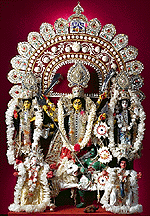
Image of Hindu Goddess Durga
 |
Made by Asutosh Malakar and Sons, Calcutta, India, 1935; modelled clay figures with ornaments of paper, tin, wood, foil and plant fibres; 143 x 91 x 43 cm.; gift of Deshantari Bengali Multicultural Association, Ottawa Few occasions in the Hindu calendar are more colourful than the autumn festival of Durga Puja, which celebrates the triumph of good over evil. This event is the highlight of the year for people from the Indian state of West Bengal, but is also observed throughout India and wherever Hindus live. The Durga image is the focus of five days of celebration and worship, after which it is cast into the river to symbolize the cycle of birth and death and the return of the goddess and humans to their regular activities. This image shows the powerful goddess Durga, personifying knowledge and righteousness, slaying the Buffalo Demon, who represents darkness, evil and ignorance. Seated on her lion, Durga is attended by the gods of war and auspicious beginnings and by the goddesses of wealth and the arts. Many craftsmen have combined their skills to produce a vibrant object of worship. The Museum's image was, for several years, the focus of the annual Durga Puja organized by the Bengali cultural association of Ottawa. When a new image was brought from Calcutta, this one escaped its traditional fate to become part of the Museum's collections. |
